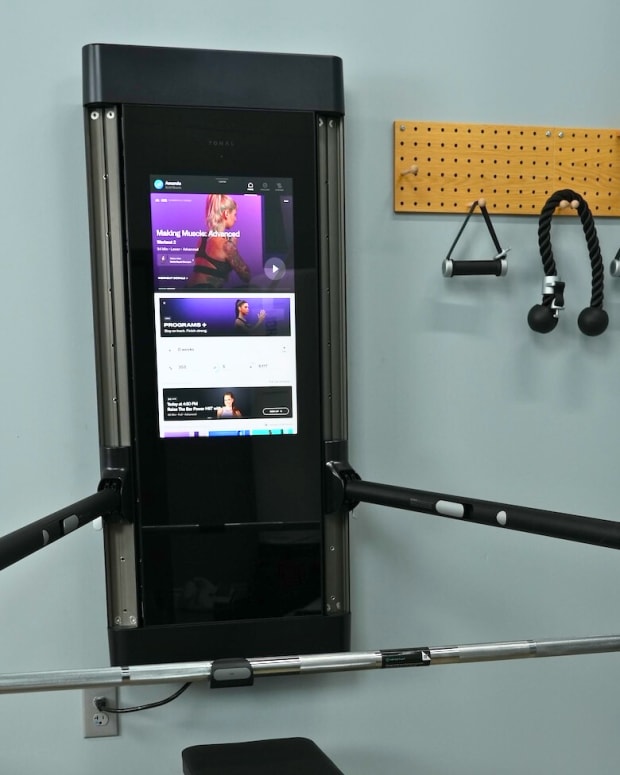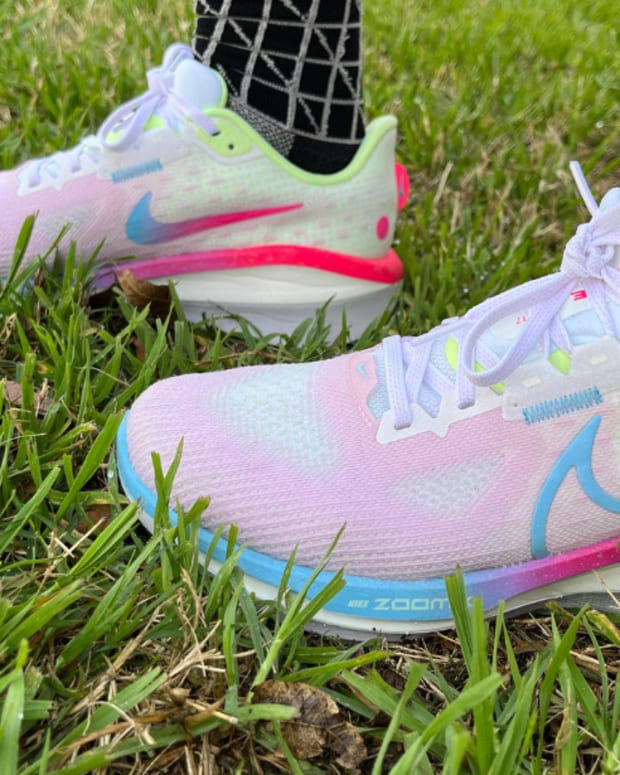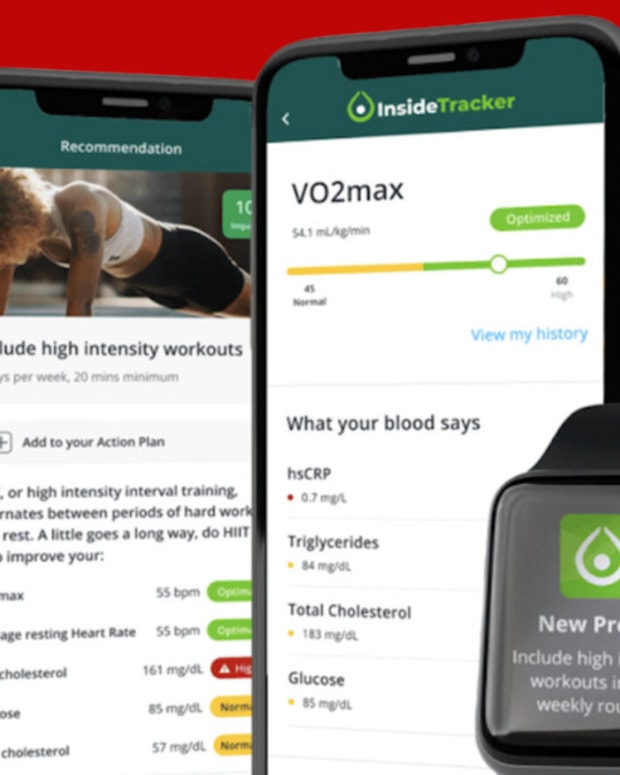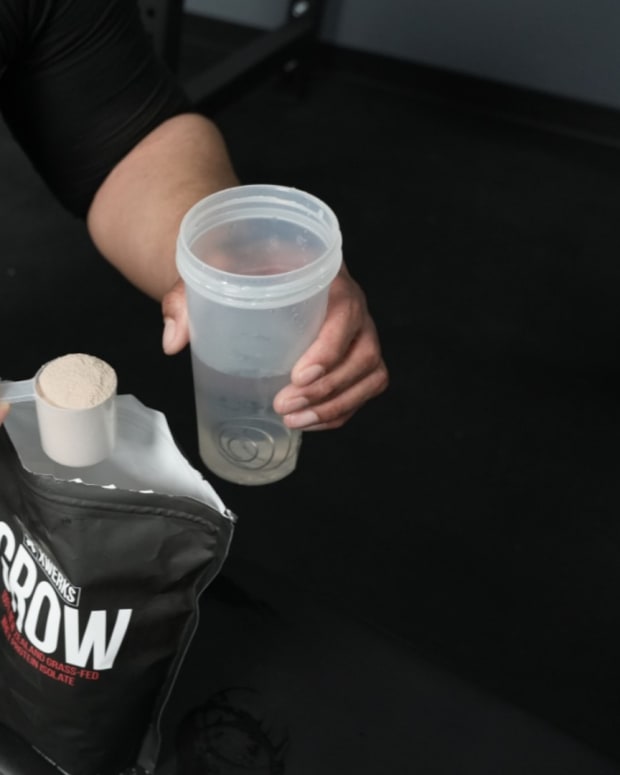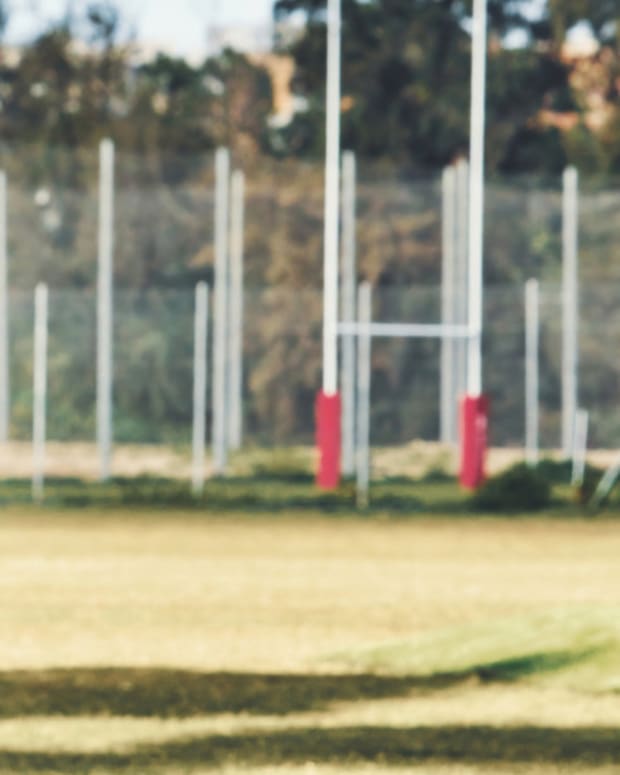The products featured in this article have been independently reviewed. When you buy something through the retail links on this page, we may earn commission at no cost to you, the reader. Sports Illustrated editorial staff are not involved in the creation of this content. Learn more here.
Classic front and back barbell squats target the glutes, quadriceps and hamstrings by loading weight on your shoulders. That weight also loads your spine, activating the abdominal and back muscles to stabilize the body. Unfortunately, the load can lead to lower back pain that’s a common issue for both beginners and experienced weightlifters.
Belt squats take the weight and pressure off of your lower back by loading weight on the hips, yet this move engages the lower body, similar to a standard squat. Adding a belt squat machine to your home gym can save your lower back while providing a lower body workout to keep seeing muscle and strength gains. They’re a great option for powerlifting, too, because the movement protects the back from high-weight lifts while building strength.
The best belt squat machines should fit in your home gym and complement your workout goals and budget. The machines on our list vary in size, weight capacity and price. Some are add-ons to a power rack, and others are standalone machines. Keep reading to get the lowdown on the standout models on our list with a few tips for picking the right machine for your goals.
Our Picks for the Best Belt Squat Machines:
- Best Belt Squat Machine Attachment: REP Fitness Belt Squat
- Best Belt Squat Machine for Heavy Lifting: Titan Fitness Belt Squat Machine
- Best Belt Squat Machine with Removable Belt: DB Method Essentials Kit
- Best Compact Belt Squat Machine: Rogue Monster Rhino Belt Squat
Best Belt Squat Machine Attachment: REP Fitness Belt Squat
Key Features:
- Dimensions: 8.1 inches high x 25.3 inches long x 41.3 inches wide
- Warranty: Structural welds: limited lifetime; bolts/pins/cables: one year
- Weight: 41 pounds
- Weight capacity: 600 pounds with iron plates, 300 pounds with bumpers
- Special features: Can be used for calf raises, pull-ups, biceps curls, single-leg box lunges, removable attachment for PR-4000 or PR-5000 V2 power racks
REP makes commercial-grade gym equipment for your home and professional gyms. If you own a REP PR-4000 and PR-5000 V2 rack, the REP Fitness Belt Squat attachment expands your squat and workout options significantly. REP racks have numbered bolt holes throughout the frame so you can add various rack attachments.
The Fitness Belt Squat is a relatively compact way to add a belt squat machine to your home gym. It can attach to the inside or outside of a compatible squat rack, but REP recommends inside the rack until you’re familiar with the movement pattern. Unfortunately, this attachment isn’t one-and-done, whether you attach it inside or outside of the frame. The use of the Fitness Belt Squat requires the lat pulldown, low row and rear base stabilizer attachment as well. This attachment includes a cable system that uses weight plates to add weight. If you attach the Fitness Belt Squat to the outside of the frame, REP also recommends the use of the front foot extension.
If you have all of those attachments, this particular attachment increases the number and variations of lifts you can do with your power rack. The bolt holes on a REP power rack are numbered, so it takes some trial and error to find the right position for the attachment, but the numbering makes it easier to line up both sides of the attachment. You have the option of starting from a squat or standing position. Starting from a standing position helps when you’re going for max or lifting at higher weights. However, because this machine is an attachment, starting from a standing position is a more complicated process than some of the standalone models.
Once attached inside the frame, you attach your own weight belt to a carabiner located in the center of the machine. REP recommends shorter belts because they require less distance between you and the carabiner to reach a point of tension. While the setup can be a little complicated with this machine, we like its versatility. It can be used for belt squats, weighted pull-ups, calf raises, biceps curls (using a lat pulldown bar) and weighted single-leg box lunges.
The attachment can handle up to 600 pounds with iron plates or 300 pounds with bumpers. REP has a limited lifetime warranty on structural welds and a one-year warranty on any pins cables or bolts, with a 30-day return window.
Pros:
- Versatile lift options
- Attaches into an existing power rack
- Holds up to 600 pounds with iron plates
- Includes a lifetime warranty on structural welds
Cons:
- Only works with the PR-4000 and PR-5000 V2 racks
- Requires the lat pulldown and low row and rear base stabilizer
- Requires the front foot extension for attached to frame exterior
Best Squat Machine for Heavy Lifting: Titan Fitness Belt Squat Machine
Key Features:
- Dimensions: 83 inches wide x 52 inches deep x 38.5 inches high
- Warranty: One year
- Weight: 232 pounds
- Weight capacity: 1,000 pounds
- Special features: Weight posts, weight stopper, handrail, includes weightlifting belt
The Titan Fitness Belt Squat is a standalone machine with a lever system designed to develop maximum explosive power. The footprint at 83 inches x 52 inches x 38.5 inches is on the large side, so you need a dedicated space. Plus, weight plates are not included with the purchase, which can add to the overall cost. But this machine can handle up to 1,000 pounds, giving pros (and Joes) plenty of range to play with.
Titan’s belt squat machine comes with a few extras that make it worth the fairly significant price tag. For one it has an adjustable weight stopper that sets the squat depth. This feature comes in handy, especially if you’ve got several people of different heights using the machine. It can also help as you’re developing your form, letting you gradually sink deeper into the squat while still having a stopper to protect you from injury due to a failed squat.
A handrail in front of the squat area offers added stability. While this hasn’t been expressly stated with this machine, some users can find that lever systems pull the body forward through the squat motion. The handrail position alters that extra stability at any point throughout the squat.
A textured footplate is counterbalanced with four weight posts on the back of the machine. You can store weight plates here, though they are sold separately. Last, Titan provides a weight belt that you attach to the lever arm, eliminating the need to buy one separately. A belt specifically meant for this machine also assures that the belt length is right. One reviewer on the Titan Fitness website wrote the machine, “works the legs really good without hurting your back! Easy to setup up and use. Top quality and well manufactured. You can use this machine not just for legs, but you can do shrugs, single-leg lunges and calves.” Lever machines aren’t quite as versatile as cable systems, but it can be used for several other lifts.
The only thing we don’t love about this model is the short one-year warranty.
Pros:
- High maximum weight capacity of 1,000 pounds
- Weight stopper to adjust the squat depth
- Handrail for stability
- Plate storage and counterbalance
Cons:
- Short one-year warranty
- Weight plates are not sold with the machine
Best Belt Squat Machine with Removable Belt: DB Method Essentials Kit
Key Features:
- Dimensions: 45.5 inches long x 20 inches wide x 39.5 inches high
- Warranty: One year
- Weight: 29.5 pounds
- Weight capacity: Uses body weight with a maximum user weight of 250 pounds
- Special features: Folds for storage, transport wheels
The DB Method can cause a bit of a stir in weightlifting circles, especially among those who love the belt squat. That’s because it’s not a traditional belt squat machine. But in many ways, it functions as one. The machine’s design takes weight and stress off of the shoulders and back (and knees if we’re getting technical), isolating the glutes and quads. We’re putting it in the same category as a belt squat machine because of how it protects the upper body while working the lower body.
The DB Method doesn’t require a weight belt, though you can buy a weighted belt to add resistance as you become more proficient. Instead, it relies solely on body weight and the natural movement of a squat.
This machine’s seat and frame design puts you in a body position your reduces stress on the knees and back, with handles to support your body and maintain stability. An adjustable seat lengthens to accommodate users of different heights, from five feet to six feet three inches tall. The DB Method works the lower body similarly to a belt squat, except that it activates the glutes more like a barbell-loaded squat. It also allows users to go through a full range of motion. You don't have to go below parallel on the DB Method, but with the support of the handles and seat, it’s an option for people who might otherwise not be able to.
We also like this machine’s compact footprint and folding design. When folded it measures just seven inches high, easily sliding under a bed or standing against a wall in a closet. Weighing in at only 29.5 pounds, it is by far one of the most compact and lightweight belt squat options. Plus, it has transport wheels to easily move it around your gym or home.
The DB Method essentials kit comes with the machine, a resistance band, 10 pound weighted belt and a workout mat.
The downside with the DB Method is that you can’t max out your squat. It’s primarily designed to use body weight. You can use the weighted belt to increase the weight load, but those who want to continue to increase their belt squat max can’t do that with this machine.
Pros:
- Compact and lightweight
- Easy to transport
- Isolates the glutes while protecting the knees and back
Cons:
- Can’t max out
- Short one-year warranty
Best Compact Belt Squat Machine: Rogue Monster Rhino Belt Squat
Key Features:
- Dimensions: 60.5 inches long x 49 inches wide x 78.5 inches high
- Warranty: structural welds and frame - limited lifetime warranty; bearings, pulley wheels, cables, sealed roller bearings - five year
- Weight: 530 pounds
- Weight capacity: 1,000 pounds
- Special features: Rogue multi-belt
The Rogue Monster Rhino Belt Squat has an appropriate name because it is a monster of a belt squat machine. It comes with a significant price tag, but it’s a versatile, durable machine for those with a dedicated home or garage gym. This solid 530-pound machine is 60.5 inches long by 49 inches wide by 78.5 inches high. It can hold 1,000 pounds at its maximum and is designed for versatility and expansion.
The Monster Rhino basically functions as a ground-level cable machine with a foot platform and center cable tower. It actually comes in several variations, including a drop-in model for Rogue power racks, an attachment for Rogue power racks and this standalone model. A trolley at the center of the machine holds the weight plates. There’s no need to worry about even weight on either side of the trolley. It creates equal resistance no matter which side holds the weights.
A “rhino horn,” which looks like a small J-cup, holds the trolley and weight. Once you get in position on the platform, you pull on the handles connected to the horn to release the weight and start the squat. You hold those handles throughout the squat, releasing them when you’re finished with the rep or set.
The Monster Rhino’s design opens the doors to a versatile array of potential lifts. You can attach straps and handles to do lifts like bicep curls and upright rows. Users can customize the fit with the adjustable handles, using the bolt holes and pins to get the right fit for your height and squat depth.
A couple of precautions and things to think about—the Monster Rhino must be bolted in place for stability. Unlike the other two variations of this machine which attach to a power rack, this one stands alone and needs that added stability, especially if you’re using it for any lifts off-platform. The other caution is the price. It’s high. If you don’t have weight plates, that will add to the overall cost because they are sold separately. However, you’ll be hard-pressed to find a smoother, more stable belt squat machine. Additionally, the frame and welds have a limited lifetime warranty with bearings, pulley meals, cable and sealed roller bearings having a five-year warranty.
Pros:
- Sturdy, durable design
- Versatile lifting options
- Trolley can be loaded with uneven amounts of weight
- High maximum weight
Cons:
- Expensive
- Must be bolted to the floor
How To Choose the Best Belt Squat Machine for Your Home Gym
Get out your measuring tape. The belt squat machine for you will largely depend on your available space and your budget. Those are the first two factors to consider. When measuring, make sure to check vertical space too. Some models, especially cable system machines, can have a high vertical footprint. Check how much clearance you need around the belt squat machine, too. Some require two or three feet on every side, while others don’t need much clearance at all.
Next, do you have a power rack with compatible belt squat attachments? Purchasing a budget-friendly power rack plus attachements is often an economical and space—saving way to get your hands on a belt squat machine. But look closely before buying because you may need an extra piece of equipment to use a belt squat attachment.
Some machines require weight plates, while others have a weight stack built into the machine and other machines only use body weight. Do you already have weight plates? If not, do you want to invest in them?
You should also consider your fitness goals and level. If you just want to isolate the legs and glutes while protecting your back, but aren’t looking to max out, a machine that holds 500-600 pounds will be more than enough for many people. However, if you want to build explosive power, are into powerlifting or want to increase muscle definition, a machine with a maximum weight capacity of 1,000 pounds might be in order.
Consider if you might be better served by a different machine. A power rack might be a more versatile option if you’re just starting your home gym. Others may be better served with a leg press, though the leg press isn’t nearly as versatile as most belt squat machines. If you’ve got limited space, a power rack with a belt squat attachment makes more sense than a standalone belt squat machine.
Finally, consider any additional equipment you may need. For example, some machines allow you to use your own dip belt, while others are compatible with any standard weightlifting belt. (The only type of belt you can’t usually use for belt squats are lever belts because cables and levers attach to the belt’s D-rings.) But additional equipment could be much more expensive than a belt. Some attachments require other attachments to work with power racks, for example. Just make sure you’ve got the equipment you need or are willing to spend money on the equipment you need to use your chosen belt squat machine.
How We Chose the Best Belt Squat Machines
The belt squat machines on our list were picked for their high-quality builds, customer satisfaction and performance. Of course, we also considered factors like the maximum weight capacity, footprint, assembly ease and warranty too.
The research process involved digging into top brands and customer and third-party reviews. We looked deeper into construction methods supported by warranties because we wanted machines with the durability to last for years. Brands and models got bonus points if they had features that allowed them to be used for additional lifts and exercises.
Maximum weight limit played a role, as did the person for whom the machine is designed. For example, not everyone wants or needs a machine that can hold 1,000 pounds. We included machines that can work for competitive Olympic or powerlifters as well as machines for those who want to strengthen and tone without straining the back, but who have no desire to increase their max. Finally, we considered the footprint. Home gyms often have limited space, which is why we included large stand-alones alongside folding models that can slide under a bed.
There are several other brands we considered, like Wenning, Squatmax-MD and the Bells of Steel. While these brands make fine models and might be a good choice for some, we opted to pick models that applied to different users and that had different systems, like pulleys or levers, to fit the variety of needs users might have.
What Is a Belt Squat Machine?
A belt squat machine has a dip or hip belt to which weights are attached to perform weighted squats. The movement puts the weight on the hips rather than on the shoulders and spine when doing barbell-loaded squats. Before belt squat machines were invented, weightlifters stood on two boxes with a weight dangling from a weightlifting belt. The weight would dangle between the boxes at the bottom of the squat. The problem with this method is that it’s difficult to get into and out of position on your own. Consequently, the belt squat machine was born.
Barbell-loaded squats put a lot of strain on the shoulders, spine and back. It can cause back pain, especially as you lift higher weights. Belt squat machines forgo the stress on the spine and torso while still letting you work the lower body.
However, muscle engagement isn’t exactly like barbell squats. According to a 2020 study, there’s less glute involvement with belt squats when compared to a barbell-loaded squat. A belt squat engages more quadricep strength. The glutes are still engaged. They’re just not the star of the show. Alternating your belt squats with barbell squats can offer more quad isolation, which can only enhance your barbell squat strength, too. But if you’re exclusively doing belt squats, you might want to add in a few hip thrusters to target the glutes.
Types of Belt Squat Machines
There are three types of belt squat machines; lever systems, pulley systems and free-weight systems. There’s a fourth, though somewhat controversial, belt squat machine that’s more like a squat assist machine.
A lever system puts the weight, usually in the form of weight plates, on the lever and a pivot point. You stand on a platform with a weightlifting belt attached to the lever. These machines often have high maximum weight limits because you can load them with weight plates. However, they tend to be wide because of the weight posts extending to the outside of the machine. Some users also find that these machines pull them forward in the squat, making it hard to stay in optimal squatting position.
Belt squat machines with a pulley system have a platform with a cutout in the center through which you attach a weight belt to a cable. They may have a weight stack or use weight plates connected to a trolley that you lift during the squat. These machines typically offer smoother movement than the other belt squat machine types, but they can be expensive. Depending on the design, they can also have a large footprint.
Free-weight machines are basically a platform with a hole in the center with a device in that hole that holds weight plates. A weight belt is attached to the device and provides stability as you do the belt squats. These machines are not as common, but take up less vertical space because they don’t require weight posts at the sides of the machine. However, they’re not as versatile as either a lever system or pulley system. Both pulley and lever open the door to other lifts, like tricep extensions, bicep curls and potentially weight pull-ups.
The last belt squat machine, that’s not always classified as a belt squat machine, are those that are more like a squat assist machine. These machines rely on body position, seats and handles to take stress and pressure off the back and knees. They also use body weight to provide resistance. Think of these models as a budget belt squat machines. These machines are effective to a point. However, if you’re looking to build muscle mass, you’ll need a machine that lets you incrementally increase the load, such as one with weight plates or a stack.
Benefits Of a Belt Squat Machine
Belt squat machines offer many benefits. First, they take weight and stress off of the spine, shoulders, lower back and abdominals. As some people increase their squat weight, they experience pain in the upper body, usually the lower back and shoulders. Belt squats remove weight from the shoulders to the hips. You still challenge the lower body without the wear tear on your upper body.
Second, belt squats increase activation in the quads in comparison to a barbell-loaded front or back squat. The added isolation can enhance some training programs. However, that also means there’s less glute activation, so you might want to couple your belt squats with glute-specific lifts, like hip thrusters or alternating between belt squats and barbell-loaded squats.
Last, belt squat machines let you do more than squat. Depending on the design of the machine, you may be able to do bicep curls, weighted pull-ups, upright rows, calf raises and other exercises. They’re a much more versatile machine than you might think. Use your creativity, and the manufacturer’s instructions and videos to discover what you can do before buying the machine.
Belt Squat Machine Vs. Barbell Back Squat Machine
Barbell back squat machines, more popularly called Smith machines, have barbells on a fixed track with J-cups along the track into which you can drop the barbell at any time. Weight, in the form of weight plates, is loaded onto the barbell. You can then place the weight on the front or back of the shoulders. Smith machines are also useful for doing bench press and deadlifts. Again, they’re a great option if you don’t have a spotter while working out.
Smith machines are a great choice for beginners because they stabilize the barbell and have built-in spotting thanks to the J-cups along the track. The movement activates the same muscle groups as a barbell-loaded back or front squat. They take some stress off of the upper body when doing a barbell-loaded squad. However, the shoulders and spine will still be used for stability, which could cause back issues for some people. Smith machines have gotten a bad reputation in some circles because they don’t require the same balance and stability as using a free barbell.
In contrast, a belt squat machine loads weight onto the hips, sparing the shoulders and low back. The goal is to load the weight vertically, but some machines, especially lever systems sometimes pull the body forward a little. The weight placement also engages more of the quadriceps than a standard squat.
Belt Squat Machine FAQs
What is the rep range for belt squats?
Rep range depends on the weight load—the more weight, the lower the rep range. However, a good place to start is three sets of eight to 12 reps, with the goal of failing on the last rep. Your specific goals and workout may require more weight with a lower rep range to maximize muscle gain.
What weight should I start with on a belt squat machine?
Most people start at a weight that’s a little below their barbell-loaded back or front squat weight. The spine and upper body muscles support some of the weight in a back squat, but with a belt squat, the weight is entirely on the legs.
Do belt squats build glutes?
Belt squats aren’t the best for building glutes. The weight placement engages more of the quadriceps than the glutes. That doesn’t mean your glutes are napping. It means a belt squat isn’t the right exercise if you want to build your glutes. Think hip thrusters and Russian deadlifts for more glute-specific exercises.
What is the purpose of a belt squat machine?
Before belt squat machines, lifters stood on boxes with a weight dangling from a weight belt. Belt squat machines let you do the same movement in a much more convenient and safe position. More importantly, you can do them without the help of a spotter, which is required for the box and belt method.
Who should buy a belt squat machine?
Anyone who experiences back pain when doing barbell-loaded squats can benefit from a belt squat machine. This type of machine might also be good for you if you want to target the quadriceps and hamstrings. Belt squat machine gives you an alternative way to work your lower body. These machines can also be useful for those who want to expand the exercises they can do with their existing machines. For example, you can use it for bicep curls, weighted calf raises or tricep extensions. It all depends on the design in your existing set up.
Final Thoughts
Belt squat machines can be a valuable addition to a home gym. They’re versatile, but they do require some space. However, one of these machines can also save your back and shoulders from pain and discomfort.
Take the gym measurements, and decide on a budget. You might have to get yourself a heavy-duty belt or a few weight plates to get the lower body results you want. From there, consistency and a program built on gradual overload will keep developing your legs. It’s worth it if you’re ready to add belt squats into your regular workout rotation.
Prices are accurate and items in stock as of publish time.





